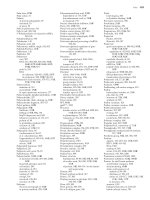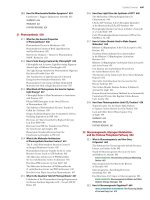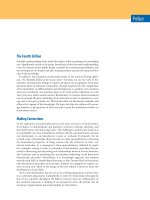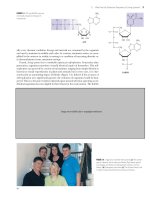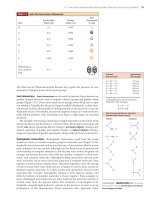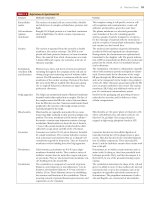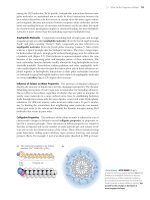Biochemistry, 4th Edition P69 pdf
Bạn đang xem bản rút gọn của tài liệu. Xem và tải ngay bản đầy đủ của tài liệu tại đây (2.12 MB, 10 trang )
21.4 What Is the Molecular Architecture of Photosynthetic Reaction Centers? 643
phyll (BChl). The e
Ϫ
is then transferred via the L bacteriopheophytin (BPheo) to
Q
A
, which is also an L prosthetic group. The corresponding site on M is occupied by
a loosely bound quinone, Q
B
, and electron transfer from Q
A
to Q
B
takes place. An
interesting aspect of the system is that no electron transfer occurs through M, even
though it has components apparently symmetric to and identical to the Le
Ϫ
transfer
pathway.
The reduced quinone formed at the Q
B
site is free to diffuse to a neighboring
cytochrome bc
1
membrane complex, where its oxidation is coupled to H
ϩ
transloca-
tion and, hence, ultimately to ATP synthesis. The use of light energy to drive ATP
synthesis by the concerted action of these membrane proteins is called photophos-
phorylation (Figure 21.15).
Cytochrome c
2
, a periplasmic protein, serves to cycle electrons back to P870
ϩ
via
the four hemes of the reaction center cytochrome subunit. A specific tyrosine
residue of L (Tyr
162
) is situated between P870 and the closest cytochrome heme.
This Tyr is the immediate e
Ϫ
donor to P870
ϩ
and completes the light-driven elec-
tron transfer cycle.
The Molecular Architecture of PSII Resembles the R. viridis Reaction
Center Architecture
Type II photosystems of higher plants, green algae, and cyanobacteria contain
more than 20 subunits and are considerably more complex than the R. viridis
reaction center. The structure of PSII from the thermophilic cyanobacterium
Light
Outside
Cytoplasm
Cyt c
2
Cyt c
2
QH
2
Q
B
Q
A
LM
H
2H
+
Fe
2H
+
4H
+
4H
+
4H
+
Bacterial
F
1
F
0
–ATP
synthase
+ P
i
2e
–
Q
2 H
+
Cyt b/c
1
ATP
ADP
ACTIVE FIGURE 21.15 Photophosphorylation. Photoexcitation of the R. viridis RC leads to
reduction of a quinone, Q, to form QH
2
. Oxidation of QH
2
by the cytochrome bc
1
complex leads to H
ϩ
trans-
location for ATP synthesis by the R. viridis F
1
F
0
–ATP synthase. Test yourself on the concepts in this figure at
www.cengage.com/login.
644 Chapter 21 Photosynthesis
Synechococcus elongatus has been revealed by X-ray crystallography, providing insight
into PSII structures in general. Interestingly, both type II and type I photosystems
show significant similarity to the R. viridis reaction center, thus establishing a
strong evolutionary connection between reaction centers.
S. elongatus PSII is a homodimeric structure. Each “monomer” has a mass of
almost 350 kD and 23 different protein subunits, the 4 largest being the reaction
center pair of subunits (D1 and D2) and two chlorophyll-containing inner antenna
subunits (CP43 and CP47) that bracket D1 and D2 (Figure 21.16). Together, CP43
and CP47 have a total of 26 Chl a molecules, and exciton energy is collected and
transferred from them to P680. Collectively, the protein subunits in a PSII
“monomer” have at least 34 transmembrane ␣-helical segments, 22 of which are
found in the D1-D2-CP43-CP47 “core” structure. D1 and D2 each have five
membrane-spanning ␣-helices. Structurally and functionally, these two subunits are
a direct counterpart of the L and M subunits of the R. viridis reaction center. P680
consists of a pair of Chl a molecules, with D1 and D2 each contributing one. D1 and
D2 each have two other Chl a molecules, one near each P680 (Chl
D1
and Chl
D2
, re-
spectively) and another that interacts with CP43/CP47 (Chl
Z-D1
and Chl
Z-D2
, respec-
tively) (Figure 21.16). Two equivalents of pheophytin (Pheo) are located on D1 and
D2. The tyrosine species D is Tyr
161
in the D1 amino acid sequence. Complexed to
D2 is a tightly bound plastoquinone molecule, Q
A
. Electrons flow from P680* to
Chl
D1
and on to Pheo
D1
. Pheo
D1
then transfers the electron to Q
A
on D2, where it
then moves to a second plastoquinone situated in the Q
B
site on D1 (Figure 21.16).
Electron transfer from Q
A
and Q
B
is assisted by the iron atom located between
them. Each plastoquinone that enters the Q
B
site accepts two electrons derived
from water and two H
ϩ
from the stroma before it is released into the membrane as
the hydroquinone PQH
2
. Thus, two photons are required to reduce each PQ that
enters the Q
B
site. The stoichiometry of the overall reaction catalyzed by PSII is
2 H
2
O ϩ 2 PQ ϩ 4 h ⎯⎯→ O
2
ϩ 2 PQH
2
. The (Mn)
4
complex is located on the
Fe
Phe
D1
Phe
D2
Chl
D1
Chl
D2
P
D1
P
D2
Y
Z
Y
D
Chl
Z-D1
Chl
Z-D2
D1 D2
(Mn)
4
CP43 CP47
Stroma
Thylakoid
lumen
Q
A
Q
B
(a)
(b)
FIGURE 21.16 Molecular architecture of the Synechococ-
cus elongatus PSII dimer. (a) The arrow shows the path of
electron transfer from P680* to Chl
D1
to Pheo
D1
to Q
A
on D2 and then, via the Fe atom, to Q
B
on D1.The Tyr
161
residue of D1, symbolized by Y
z
, is situated between
P680 and the (Mn)
4
cluster. (b) Structure of S. elongatus
PSII (pdb id ϭ 1S5L). Chlorophylls of the reaction center
and electron transfer path are shown in green; pheo-
phytins, in blue.The OECs are shown in brick red.
(Adapted from Barber, J., 2003.Photosystem II:The engine of life.
Quarterly Review of Biophysics 36:71–89.)
Go to CengageNOW and click
CengageInteractive to explore the R. viridis reaction
center, a complex scaffold for transduction of light
energy.
21.4 What Is the Molecular Architecture of Photosynthetic Reaction Centers? 645
lumenal side of the thylakoid membrane. Thus, protons liberated from H
2
O mole-
cules at the Mn site are deposited directly into the lumen.
How Does PSII Generate O
2
from H
2
O?
PSII catalyzes what is probably the most thermodynamically difficult reaction in na-
ture, the light-driven oxidation of water to molecular oxygen. The protons and elec-
trons released in this reaction are used to reduce NADP
ϩ
to NADPH and to estab-
lish a proton gradient across the photosynthetic membrane that can be tapped to
drive chemiosmotic ATP synthesis (see Figure 21.20). Accumulation of molecular
oxygen in the atmosphere as a by-product of the photo-oxidation of water has trans-
formed the planet since the evolutionary appearance of this reaction some 2 billion
years ago in cyanobacteria. How does PSII evolve oxygen?
The Structure of the Oxygen-Evolving Complex The architecture of the S. elon-
gatus photosynthetic OEC reveals a large globular protein domain juxtaposed on the
lumenal side of the D1 subunit of PSII (Figure 21.16). The active site of the OEC
contains a cubelike metal cluster that consists of four manganese ions, one calcium
ion, and five oxygen atoms bridging the Mn atoms, as shown in Figure 21.17. This
metal cluster is held by Glu
189
, Asp
342
, His
332
, and His
337
of the PSII D1 subunit and
Glu
354
of CP43. Chloride ion (Cl
Ϫ
) is required for O
2
evolution, and Cl
Ϫ
is believed
to be a Ca
2ϩ
ligand. Note also that Tyr
161
(Y
Z
) is situated near the metal cluster, ide-
ally poised to serve in electron transfer between H
2
O and P680
ϩ
. When four e
Ϫ
have
been removed from the cluster (one from each Mn atom) through e
Ϫ
transfer to
PSII via Tyr
161
, two H
2
O molecules provide the four e
Ϫ
needed to re-reduce the Mn
atoms and O
2
is evolved. The four H
ϩ
released contribute to the proton gradient.
The Molecular Architecture of PSI Resembles the R. viridis Reaction
Center and PSII Architecture
The structure of PSI from the cyanobacterium S. elongatus also has been solved
by X-ray crystallography, completing our view of reaction center structure and
confirming the fundamental similarities in organization that exist in these energy-
transducing integral membrane proteins. Because of direct correlations with infor-
mation about eukaryotic PSI, this cyanobacterial PSI provides a general model for all
P700-dependent photosystems.
S. elongatus PSI exists as a cloverleaf-shaped trimeric structure. Each “monomer”
(356 kD) consists of 12 different protein subunits and 127 cofactors: 96 chlorophyll a
molecules, 2 phylloquinones, 3 Fe
4
S
4
clusters, 22 carotenoids, and 4 lipids that are an
intrinsic part of the protein complex (Figure 21.18). All of the electron-transferring
prosthetic groups essential to PSI function are localized to just three polypeptides:
PsaA, PsaB, and PsaC. PsaA and PsaB (83 kD each) compose the reaction center het-
erodimer, a structural pattern now seen as universal in photosynthetic reaction centers.
PsaA and PsaB each have 11 transmembrane ␣-helices, with the 5 most C-terminal
␣-helices of each serving as the scaffold for the reaction center photosynthetic electron-
transfer apparatus. PsaC interacts with the stromal face of the PsaA–PsaB heterodimer.
PsaC carries the two Fe
4
S
4
clusters, F
A
and F
B
, and interacts with PsaD. Together they
provide a docking site for ferredoxin. The electron-transfer system of PSI consists of
three pairs of chlorophyll molecules: P700 (a heterodimer of Chl a and an epimeric
form, Chl aЈ) and two additional Chl a pairs (symbolized by A
0
) that mediate e
Ϫ
trans-
fer to the quinone acceptor. The S. elongatus quinone acceptor (A
1
) is phylloquinone
(also known as vitamin K
1
). The Fx Fe
4
S
4
cluster bridges PsaA and PsaB; two of its four
cysteine ligands come from PsaA, the other two from PsaB. Photochemistry begins
with exciton absorption at P700, almost instantaneous electron transfer and charge
separation (P700
ϩ
ϺA
0
Ϫ
), followed by transfer of the electron from A
0
to A
1
and on
to F
X
and then F
A
and F
B
, where it goes on to reduce a ferredoxin molecule at the
“stromal” side of the membrane. The positive charge at P700
ϩ
and the e
Ϫ
at F
A
/F
B
represent a charge separation across the membrane, an energized condition created
His
332
Asp
170
Asp
342
CP43
Glu
354
Glu
333
Tyr
161
His
190
His
337
Gln
165
Glu
189
Mn
A
Mn
B
Mn
C
Mn
D
Ca
Ala
344
(C-term)
FIGURE 21.17 Structure of the PSII oxygen-evolving
complex (OEC). Four Mn atoms (red, lettered A–D) and a
Ca atom (green) form the water-splitting metal cluster
of the OEC. Bridging O atoms are purple. (Adapted from
Figure 4 in Yano, J.,et al., 2006.Where water is oxidized to dioxy-
gen: Structure of the photosynthetic Mn
4
Ca cluster.
Science 314:821–825.)
646 Chapter 21 Photosynthesis
FeS
A
FeS
B
FeS
X
P700
A
1
O
O
O
O
A
0
Plastocyanin
Plastocyanin
docking
Lumen
PsaA
PsaB
PsaC
PsaD
Ferredoxin
docking
Ferredoxin
PsaF
(a) (b)
FIGURE 21.18 The molecular architecture of PSI. (a) Subunit organization. (Adapted
from Golbeck, J.H., 1992. Structure and function of photosystem I. Annual Review of Plant Physi-
ology and Plant Molecular Biology 43:293–324; and Fromme, P., Jordan,P., and Krausse, N., 2001.
Structure of photosystem I. Biochimica Biophysica Acta 1507:5–31.)
(b) Molecular graphic of
theoretical model for PSI. PsaA is orange; PgaB is magenta; PsaC is yellow.The iron-
sulfur clusters are red (pdb id ϭ 1YO9).
FIGURE 21.19 View of the plant PSI-LHC1 supercom-
plex, from the stromal side of the thylakoid membrane.
ChI molecules are shown in green and carotenoids
and lipids in red.The 16 protein subunits are shown as
ribbon diagrams in the background, with the positions
of PsaG, PsaH, PsaK, and LHC1-4 subunits indicated.
(Adapted from Figure 4 in Nelson, N.,and Yocum, C. F., Structure
and function of photosystems I and II. Annual Review of Plant
Biology 57: 521–566 (2006). Figure courtesy of the authors.)
21.5 What Is the Quantum Yield of Photosynthesis? 647
by light. Plastocyanin (or in cyanobacteria, a lumenal cytochrome designated cyto-
chrome c
6
) delivers an electron to fill the electron hole in P700
ϩ
.
How Do Green Plants Carry Out Photosynthesis?
Do the higher plant photosystems follow the structural and functional pattern
first revealed in the bacterial RC and recapitulated in the cyanobacterial PSI and
PSII? With new structural information for the higher plant PSI (from Pisum
sativum, garden pea) and PSII (from spinach), the fundamental organization
pattern for photosystems seen earlier is confirmed for higher plants. Further, the
structure of a plant membrane protein supercomplex consisting of the PSI reac-
tion center and its light-harvesting antenna LHC1 (light-harvesting complex 1)
has been described. This supercomplex exists as a “monomer” composed of 16
distinct protein subunits and about 200 prosthetic groups, including 167 chloro-
phylls, 2 phylloquinones, and 3 Fe
4
S
4
clusters (Figure 21.19). The four LHC1
subunits form an arc around one side of the PSI RC. A second light-harvesting
complex (LHC2) binds to another side. This plant PSI system, like all photosys-
tems, is remarkably efficient, showing a quantum efficiency of nearly 1 (one elec-
tron transferred per photon falling anywhere within the supercomplex). The
many Chl and other light-harvesting molecules of the supercomplex form an in-
tegrated network for highly efficient transfer of light energy into P700.
21.5 What Is the Quantum Yield of Photosynthesis?
The quantum yield of photosynthesis can be defined as the amount of product
formed per equivalent of light input. In terms of exciton delivery to reaction center
Chl dimers and subsequent e
Ϫ
transfer, the quantum yield of photosynthesis typically
approaches the theoretical limit of 1. The quantum yield of photosynthesis can also
be expressed as the ratio of CO
2
fixed or O
2
evolved per photon absorbed. Interest-
ingly, an overall stoichiometry of three H
ϩ
translocated into the thylakoid vesicle has
been observed for each electron passing from H
2
O to NADP
ϩ
. Two photons per cen-
ter would allow a pair of electrons to flow from H
2
O to NADP
ϩ
(see Figure 21.11),
resulting in the formation of 1 NADPH and
ᎏ
1
2
ᎏ
O
2
. More appropriately, 4 h per cen-
ter (8 quanta total) would drive the evolution of 1 O
2
, the reduction of 2 NADP
ϩ
,
and the translocation of 12 H
ϩ
. Current estimates suggest that 3 ATPs are formed for
every 14 H
ϩ
translocated, so (12/14)3 ϭ 2.57 ATP would be synthesized from an in-
put of 8 quanta.
The energy of a photon depends on its wavelength, according to the equation
E ϭ h ϭ hc/, where E is energy, c is the speed of light, and is its wavelength. Ex-
pressed in molar terms, an Einstein is the amount of energy in Avogadro’s number
of photons: E ϭ Nhc/. Light of 700-nm wavelength is the longest-wavelength and
the lowest-energy light acting in the eukaryotic photosystems. An Einstein of
700-nm light is equivalent in energy to approximately 170 kJ. Eight Einsteins of
this light, 1360 kJ, theoretically generate 2 moles of NADPH, 2.57 moles of ATP, and
1 mole of O
2
.
Calculation of the Photosynthetic Energy Requirements for Hexose
Synthesis Depends on H
؉
/h and ATP/H
؉
Ratios
The fixation of carbon dioxide to form hexose, the dark reactions of photosynthesis,
requires considerable energy. The overall stoichiometry of this process (see Equation
21.3) involves 12 NADPH and 18 ATPs. Thus, the ATP/NADPH ratio for CO
2
fixation
is 1.5. To generate 12 equivalents of NADPH necessitates the consumption of 48 Ein-
steins of light, minimally 170 kJ each. However, if the preceding ratio of 1.29 ATPs per
NADPH is correct, only 15.5 or so ATPs would be produced for CO
2
fixation. To make
up the deficit of 2.5 ATPs would require 35 H
ϩ
or about 12 more e
Ϫ
transferred from
H
2
O to NADP
ϩ
(an additional 24 Einsteins). From 72 Einsteins, or 12,240 kJ, 1 mole
648 Chapter 21 Photosynthesis
of hexose would be synthesized. The standard free energy change, ⌬G°Ј, for hexose
formation from carbon dioxide and water (the exact reverse of cellular respiration)
is ϩ2870 kJ/mol. Note that many assumptions underlie these calculations, including
assumptions about the ATP/H
ϩ
ratio, the H
ϩ
/e
Ϫ
ratio, and ultimately, the relation-
ship between quantum input and overall yields of NADPH and ATP. Also, cyclic pho-
tophosphorylation (see later section titled Cyclic Photophosphorylation Generates
ATP but Not NADPH or O
2
) leads to ATP synthesis and may aid in making up the ATP
deficit just mentioned.
21.6 How Does Light Drive the Synthesis of ATP?
Light-driven ATP synthesis, or photophosphorylation, is a fundamental part of the
photosynthetic process. The conversion of light energy to chemical energy results
in electron-transfer reactions, which lead to the generation of reducing power (re-
duced quinones or NADPH). Coupled with these electron transfers, protons are
driven across the thylakoid membranes from the stromal side to the lumenal side.
These proton translocations occur in a manner analogous to the proton transloca-
tions accompanying mitochondrial electron transport that provide the driving force
for oxidative phosphorylation (see Chapter 20). Figure 21.11 indicates that proton
translocations can occur at a number of sites. For example, protons are produced
in the thylakoid lumen upon photolysis of water by PSII. The oxidation–reduction
events as electrons pass through the plastoquinone pool and the Q cycle are an-
other source of proton translocations. The proton transfer accompanying NADP
ϩ
reduction also can be envisioned as protons being taken from the stromal side of
the thylakoid vesicle. The current view is that three protons are translocated for
each electron that flows from H
2
O to NADP
ϩ
. Because this electron transfer re-
quires two photons, one falling at PSII and one at PSI, the overall yield is 1.5 pro-
tons per quantum of light.
The Mechanism of Photophosphorylation Is Chemiosmotic
The thylakoid membrane is asymmetrically organized, or “sided,” like the mito-
chondrial membrane. It also shares the property of being a barrier to the passive
diffusion of H
ϩ
ions. Photosynthetic electron transport thus establishes an electro-
chemical gradient, or proton-motive force, across the thylakoid membrane with the
interior, or lumen, side accumulating H
ϩ
ions relative to the stroma of the chloro-
plast. Like oxidative phosphorylation, the mechanism of photophosphorylation is
chemiosmotic.
A proton-motive force of approximately Ϫ250 mV is needed to achieve ATP syn-
thesis. This proton-motive force, ⌬p, is composed of a membrane potential, ⌬, and
a pH gradient, ⌬pH (see Chapter 20). The proton-motive force is defined as the
free energy difference, ⌬G, divided by Ᏺ, Faraday’s constant:
⌬p ϭ ⌬G/Ᏺ ϭ ⌬ Ϫ (2.3 RT/Ᏺ)⌬pH
(21.5)
In chloroplasts, the value of ⌬ is typically Ϫ50 to Ϫ100 mV and the pH gradient is
equivalent to about 3 pH units, so Ϫ(2.3 RT/Ᏺ)⌬pH ϭϪ170 mV. This situation con-
trasts with the mitochondrial proton-motive force, where the membrane potential
contributes relatively more to ⌬p than does the pH gradient.
CF
1
CF
0
–ATP Synthase Is the Chloroplast Equivalent
of the Mitochondrial F
1
F
0
–ATP Synthase
The transduction of the electrochemical gradient into the chemical energy repre-
sented by ATP is carried out by the chloroplast ATP synthase, which is highly analo-
gous to the mitochondrial F
1
F
0
–ATP synthase. The chloroplast enzyme complex is
called CF
1
CF
0
–ATP synthase, “C” symbolizing chloroplast. Like the mitochondrial
complex, CF
1
CF
0
–ATP synthase is a heteromultimer of ␣-, -, ␥-, ␦-, ⑀-, a-, b-, and
21.6 How Does Light Drive the Synthesis of ATP? 649
c-subunits (see Chapter 20), consisting of a knoblike structure some 9 nm in diame-
ter (CF
1
) attached to a stalked base (CF
0
) embedded in the thylakoid membrane. The
mechanism of action of CF
1
CF
0
–ATP synthase in coupling ATP synthesis to the col-
lapse of the pH gradient is similar to that of the mitochondrial ATP synthase de-
scribed in Chapter 20. However, higher plant CF
1
CF
0
–ATP synthase is believed to have
14 c-subunits in its F
0
rotor, implying that one turn of F
0
would require 14 H
ϩ
and lead
to synthesis of 3 ATPs. The mechanism of photophosphorylation is summarized
schematically in Figure 21.20.
Photophosphorylation Can Occur in Either a Noncyclic or a Cyclic Mode
Photosynthetic electron transport, which pumps H
ϩ
into the thylakoid lumen, can
occur in two modes, both of which lead to the establishment of a transmembrane
proton-motive force. Thus, both modes are coupled to ATP synthesis and are con-
sidered alternative mechanisms of photophosphorylation, even though they are dis-
tinguished by differences in their electron transfer pathways. The two modes are
cyclic and noncyclic photophosphorylation. Noncyclic photophosphorylation has
been the focus of our discussion and is represented by the scheme in Figure 21.20,
where electrons activated by quanta at PSII and PSI flow from H
2
O to NADP
ϩ
, with
concomitant establishment of the proton-motive force driving ATP synthesis. Note
that in noncyclic photophosphorylation, O
2
is evolved and NADP
ϩ
is reduced.
Cyclic Photophosphorylation Generates ATP but Not NADPH or O
2
In cyclic photophosphorylation, the “electron hole” in P700
ϩ
created by electron
loss from P700 is filled not by an electron derived from H
2
O via PSII but by a cyclic
pathway in which the photoexcited electron returns ultimately to P700
ϩ
. This path-
way is schematically represented in Figure 21.11 by the dashed line connecting
ferredoxin (Fd) and plastoquinone (PQ) within the membrane. This pathway di-
verts the activated e
Ϫ
lost from PSI back through the PQ pool, the cytochrome b
6
f
complex, and plastocyanin to re-reduce P700
ϩ
(Figure 21.21).
Lumen
H
2
O
PQ
2 H
+
4.5 H
+
4.5 H
+
4 H
+
Cyt b
6
Cyt b
6
Cyt f
O
2
+ 2 H
+
Q
QH
2
Plastocyanin
docking
CF
1
CF
0
–
ATP synthase
Stroma
H
+
+
NADP
+
FNR
NADPH
ADP + P
i
Cu
+
Cu
2+
PC
PC
Ferredoxin
docking
Ferredoxin
Fd
ATP
FeS
A
FeS
B
FeS
X
P700
A
1
O
O
O
O
A
0
Fe
Phe
D1
Phe
D2
Chl
D1
Chl
D2
P
D1
P
D2
Y
Z
Y
D
Chl
Z-D1
Chl
Z-D2
D1
D2
(Mn)
4
Q
A
Q
B
Photon
1
2
Photon
FIGURE 21.20 The mechanism of photophosphorylation.
Photosynthetic electron transport establishes a proton
gradient that is tapped by the CF
1
CF
0
–ATP synthase to
drive ATP synthesis.
650 Chapter 21 Photosynthesis
Proton translocations accompany these cyclic electron transfer events so that ATP
synthesis can be achieved. In cyclic photophosphorylation, ATP is the sole product
of energy conversion. No NADPH is generated, and because PSII is not involved, no
oxygen is evolved. Cyclic photophosphorylation theoretically yields 2 H
ϩ
per e
Ϫ
(2 H
ϩ
/h) from the operation of the cytochrome b
6
f complex. Thus, cyclic photo-
phosphorylation provides a mechanism for overcoming the ATP deficit for CO
2
fix-
ation (see the earlier section titled Calculation of the Photosynthetic Energy Re-
quirements for Hexose Synthesis Depends on H
ϩ
/h and ATP/H
ϩ
Ratios, page
647). Estimates indicate that cyclic photophosphorylation may contribute about 10%
of total chloroplast ATP synthesis and thereby elevate the ATP/NADPH ratio.
21.7 How Is Carbon Dioxide Used to Make
Organic Molecules?
As we began this chapter, we saw that photosynthesis traditionally is equated with the
process of CO
2
fixation, that is, the net synthesis of carbohydrate from CO
2
. Indeed,
the capacity to perform net accumulation of carbohydrate from CO
2
distinguishes the
phototrophic (and autotrophic) organisms from heterotrophs. Although animals
possess enzymes capable of linking CO
2
to organic acceptors, they cannot achieve a
net accumulation of organic material by these reactions. For example, fatty acid
biosynthesis is primed by covalent attachment of CO
2
to acetyl-CoA to form malonyl-
CoA (see Chapter 24). Nevertheless, this “fixed CO
2
” is liberated in the very next re-
action, so no net CO
2
incorporation occurs.
Elucidation of the pathway of CO
2
fixation represents one of the earliest appli-
cations of radioisotope tracers to the study of biology. In 1945, Melvin Calvin and
his colleagues at the University of California, Berkeley, were investigating photo-
synthetic CO
2
fixation in Chlorella. Using
14
CO
2
, they traced the incorporation of
radioactive
14
C into organic products and found that the earliest labeled product
was 3-phosphoglycerate (see Figure 17.14). Although this result suggested that the
CO
2
acceptor was a two-carbon compound, further investigation revealed that, in
ATP
ADP
H
+
H
+
Photon
Plastocyanin
docking
Lumen
Stroma
+ P
i
CF
1
CF
0
PC
H
+
H
+
FeS
A
FeS
B
FeS
X
P700
A
1
O
O
O
O
A
0
PQ
Cyt b
6
Cyt b
6
Cyt f
FIGURE 21.21 The pathway of cyclic photophosphoryla-
tion by PSI. (Adapted from Arnon, D. I., 1984.The discovery of
photosynthetic phosphorylation. Trends in Biochemical Sciences
9:258–262.)
21.7 How Is Carbon Dioxide Used to Make Organic Molecules? 651
reality, 2 equivalents of 3-phosphoglycerate were formed following addition of CO
2
to a five-carbon (pentose) sugar:
CO
2
ϩ 5-carbon acceptor⎯⎯→[6-carbon intermediate]⎯⎯→
two 3-phosphoglycerates
Ribulose-1,5-Bisphosphate Is the CO
2
Acceptor in CO
2
Fixation
The five-carbon CO
2
acceptor was identified as ribulose-1,5-bisphosphate (RuBP),
and the enzyme catalyzing this key reaction of CO
2
fixation is ribulose bisphosphate
carboxylase/oxygenase, or, in the jargon used by workers in this field, rubisco. The
name ribulose bisphosphate carboxylase/oxygenase reflects the fact that rubisco catalyzes the
reaction of either CO
2
or, alternatively, O
2
with RuBP. Rubisco is found in the chloro-
plast stroma. It is a very abundant enzyme, constituting more than 15% of the total
chloroplast protein. Given the preponderance of plant material in the biosphere,
rubisco is probably the world’s most abundant protein. Rubisco is large: In higher
plants, rubisco is a 550-kD heteromultimeric (␣
8

8
) complex consisting of eight iden-
tical large subunits (55 kD) and eight small subunits (15 kD) (Figure 21.22). The large
subunit is the catalytic unit of the enzyme. It binds both substrates (CO
2
and RuBP)
and Mg
2ϩ
(a divalent cation essential for enzymatic activity). The small subunit modu-
lates the catalytic efficiency of the enzyme, increasing k
cat
more than 100-fold. The ru-
bisco large subunit is encoded by a gene within the chloroplast DNA, whereas the
small subunit is encoded by a multigene family in the nuclear DNA. Assembly of ac-
tive rubisco heteromultimers occurs within chloroplasts following transit of the
small subunit polypeptide across the chloroplast membrane.
2-Carboxy-3-Keto-Arabinitol Is an Intermediate
in the Ribulose-1,5-Bisphosphate Carboxylase Reaction
The addition of CO
2
to ribulose-1,5-bisphosphate results in the formation of an
enzyme-bound intermediate, 2-carboxy-3-keto-arabinitol (Figure 21.23, II). This in-
termediate arises when CO
2
adds to the enediol intermediate generated from
ribulose-1,5-bisphosphate. Hydrolysis of the C
2
OC
3
bond of the intermediate gen-
erates two molecules of 3-phosphoglycerate. The CO
2
ends up as the carboxyl group
of one of the two molecules.
Ribulose-1,5-Bisphosphate Carboxylase Exists in Inactive
and Active Forms
Rubisco exists in three forms: an inactive form, designated E; a carbamylated, but in-
active, form, designated EC; and an active form, ECM, which is carbamylated and has
Mg
2ϩ
at its active sites as well. Carbamylation of rubisco takes place by addition of CO
2
FIGURE 21.22 Molecular graphic of ribulose bisphos-
phate carboxylase.The enzyme consists of 8 equivalents
each of two subunits. Clusters of four small subunits
(orange and red) are located at each end of the sym-
metric octamer formed by the L subunits (light and dark
green).The active sites are revealed in the ribbon dia-
gram by bound ribulose-1,5-bisphosphate (yellow)
(pdb id ϭ 1RXO).
H
2
COPO
3
2–
H
2
COPO
3
2–
H
2
COPO
3
2–
H
2
COPO
3
2–
H
2
COPO
3
2–
H
2
COPO
3
2–
H
2
COPO
3
2–
H
2
COPO
3
2–
H
2
COPO
3
2–
2
3
4
5
1
2
3
4
5
1
CO
HCOH
HCOH
C
COH
HCOH
CC
HCOH
C O
HO
III
O
O
–
O
–
CC
HCOH
C
HO
III
O
O
–
HO OH
HCOH
C
2
O
O
–
H
2
O
H
+
H
+
CO
2
FIGURE 21.23 The ribulose bisphosphate carboxylase reaction. Mg
2ϩ
at the active site aids in stabilizing the
2,3-enediol transition state (I) for CO
2
addition and in facilitating the carbon–carbon bond cleavage that leads to
product formation.
652 Chapter 21 Photosynthesis
to its Lys
201
⑀-NH
2
groups (to give ⑀ONHOCOO
Ϫ
derivatives). The CO
2
molecules
used to carbamylate Lys residues do not become substrates. The carbamylation reac-
tion occurs spontaneously at slightly alkaline pH (pH 8). Carbamylation of rubisco
completes the formation of a binding site for the Mg
2ϩ
that participates in the catalytic
reaction. Once Mg
2ϩ
binds to EC, rubisco achieves its active ECM form. Activated
rubisco displays a K
m
for CO
2
of 10 to 20 M. The relative abundance of CO
2
in the
atmosphere is low, about 0.03%. The concentration of CO
2
dissolved in aqueous so-
lutions equilibrated with air is about 10 M.
Substrate RuBP binds much more tightly to the inactive E form of rubisco (K
D
ϭ
20 nM) than to the active ECM form (K
m
for RuBP ϭ 20 M). Thus, RuBP is also a
potent inhibitor of rubisco activity. Release of RuBP from the active site of rubisco is
mediated by rubisco activase. Rubisco activase is a regulatory protein; it binds to E-form
rubisco and, in an ATP-dependent reaction, promotes the release of RuBP. Rubisco
then becomes activated by carbamylation and Mg
2ϩ
binding. Rubisco activase itself
is activated in an indirect manner by light. Thus, light is the ultimate activator of
rubisco.
CO
2
Fixation into Carbohydrate Proceeds Via the Calvin–Benson Cycle
The immediate product of CO
2
fixation, 3-phosphoglycerate, must undergo a series
of transformations before the net synthesis of carbohydrate is realized. Among car-
bohydrates, hexoses (particularly glucose) occupy center stage. Glucose is the build-
ing block for both cellulose and starch synthesis. These plant polymers constitute the
most abundant organic material in the living world, and thus, the central focus on
glucose as the ultimate end product of CO
2
fixation is amply justified. Also, sucrose
(␣-
D-glucopyranosyl-(1⎯→2)--D-fructofuranoside) is the major carbon form translo-
cated out of leaves to other plant tissues. In nonphotosynthetic tissues, sucrose is me-
tabolized via glycolysis and the TCA cycle to produce ATP.
The set of reactions that transforms 3-phosphoglycerate into hexose is named
the Calvin–Benson cycle (often referred to simply as the Calvin cycle) for its dis-
coverers. The reaction series is indeed cyclic because not only must carbohydrate
appear as an end product, but the five-carbon acceptor, RuBP, must be regenerated
to provide for continual CO
2
fixation. Balanced equations that schematically repre-
sent this situation are
6(1) ϩ 6(5)⎯⎯→12(3)
12(3)⎯⎯→1(6) ϩ 6(5)
Net: 6(1) ⎯⎯→1(6)
Each number in parentheses represents the number of carbon atoms in a com-
pound, and the number preceding the parentheses indicates the stoichiometry
of the reaction. Thus, 6(1), or 6 CO
2
, condense with 6(5) or 6 RuBP to give
12 3-phosphoglycerates. These 12(3)s are then rearranged in the Calvin cycle to
form one hexose, 1(6), and regenerate the six 5-carbon (RuBP) acceptors.
The Enzymes of the Calvin Cycle Serve Three Metabolic Purposes
The Calvin cycle enzymes serve three important ends:
1. They constitute the predominant CO
2
fixation pathway in nature.
2. They accomplish the reduction of 3-phosphoglycerate, the primary product of
CO
2
fixation, to glyceraldehyde-3-phosphate so that carbohydrate synthesis be-
comes feasible.
3. They catalyze reactions that transform three-carbon compounds into four-, five-,
six-, and seven-carbon compounds.
Most of the enzymes mediating the reactions of the Calvin cycle also participate
in either glycolysis (see Chapter 18) or the pentose phosphate pathway (see Chap-
ter 22). The aim of the Calvin scheme is to account for hexose formation from
